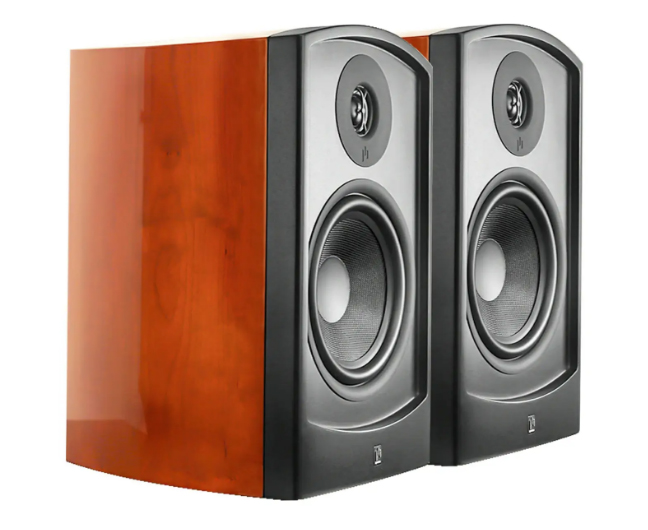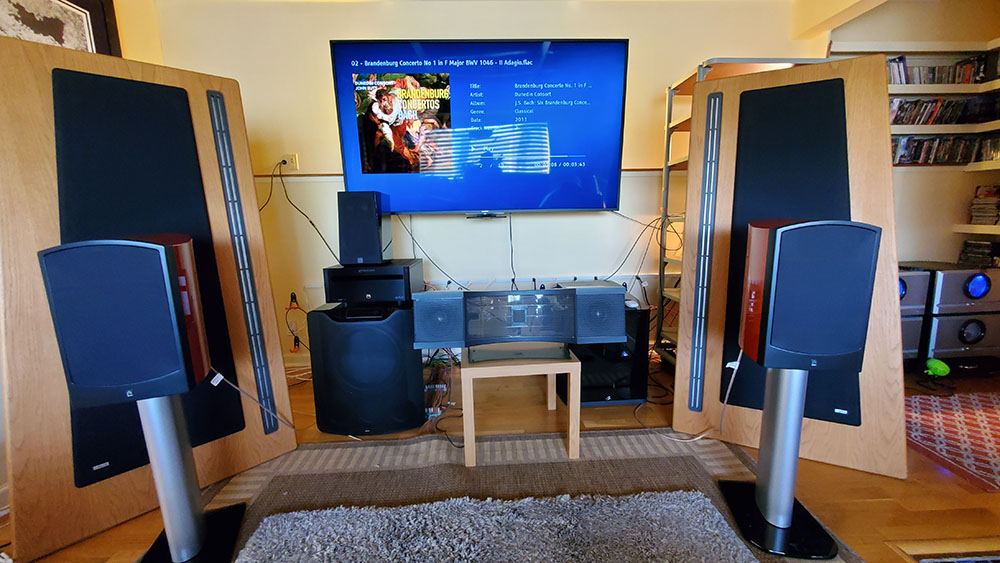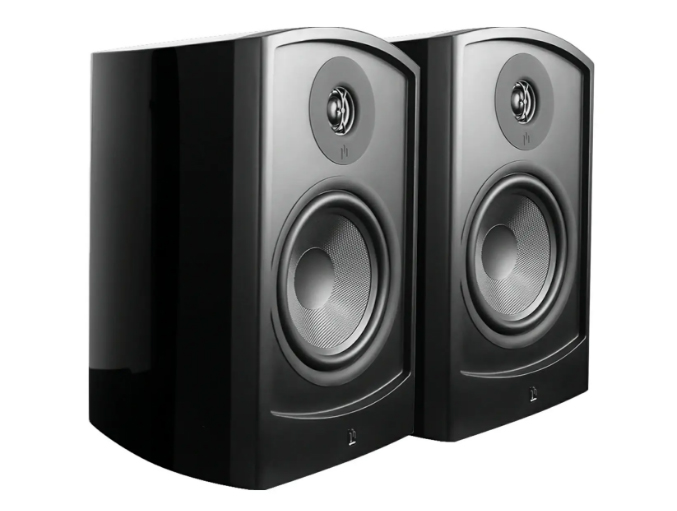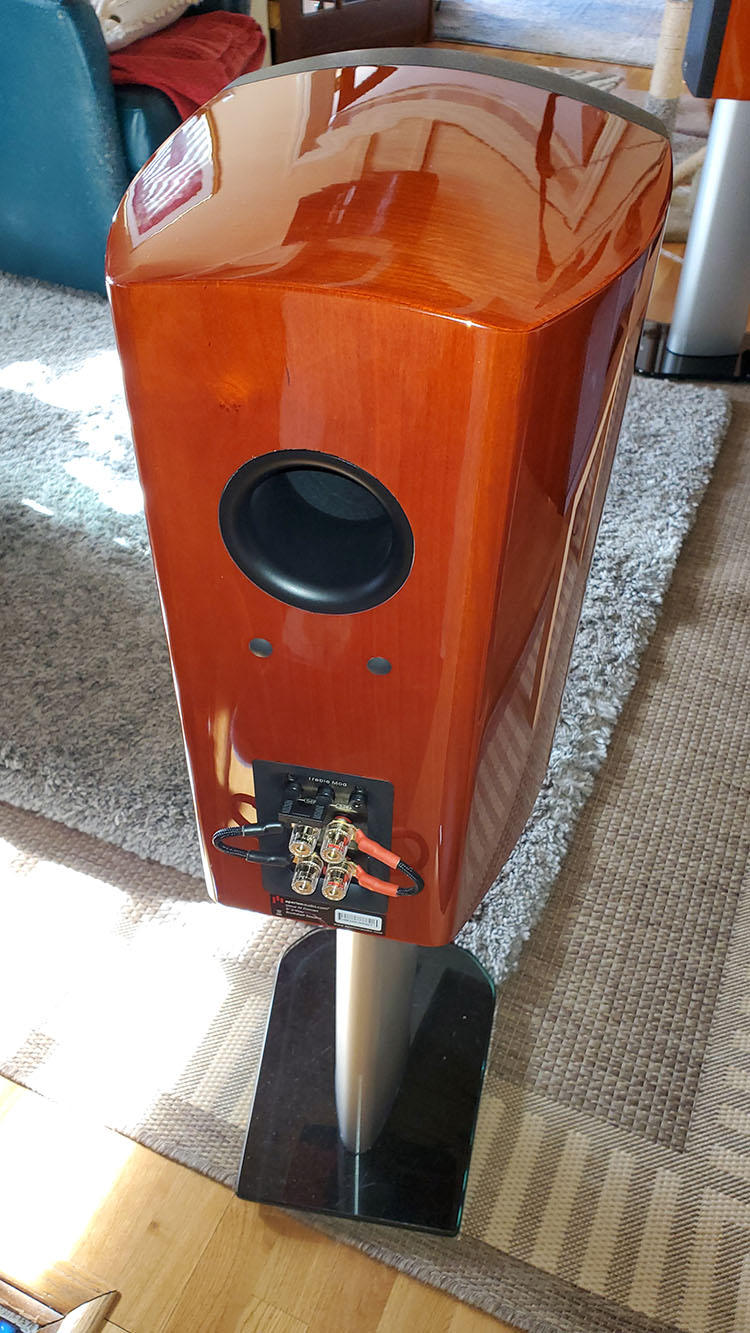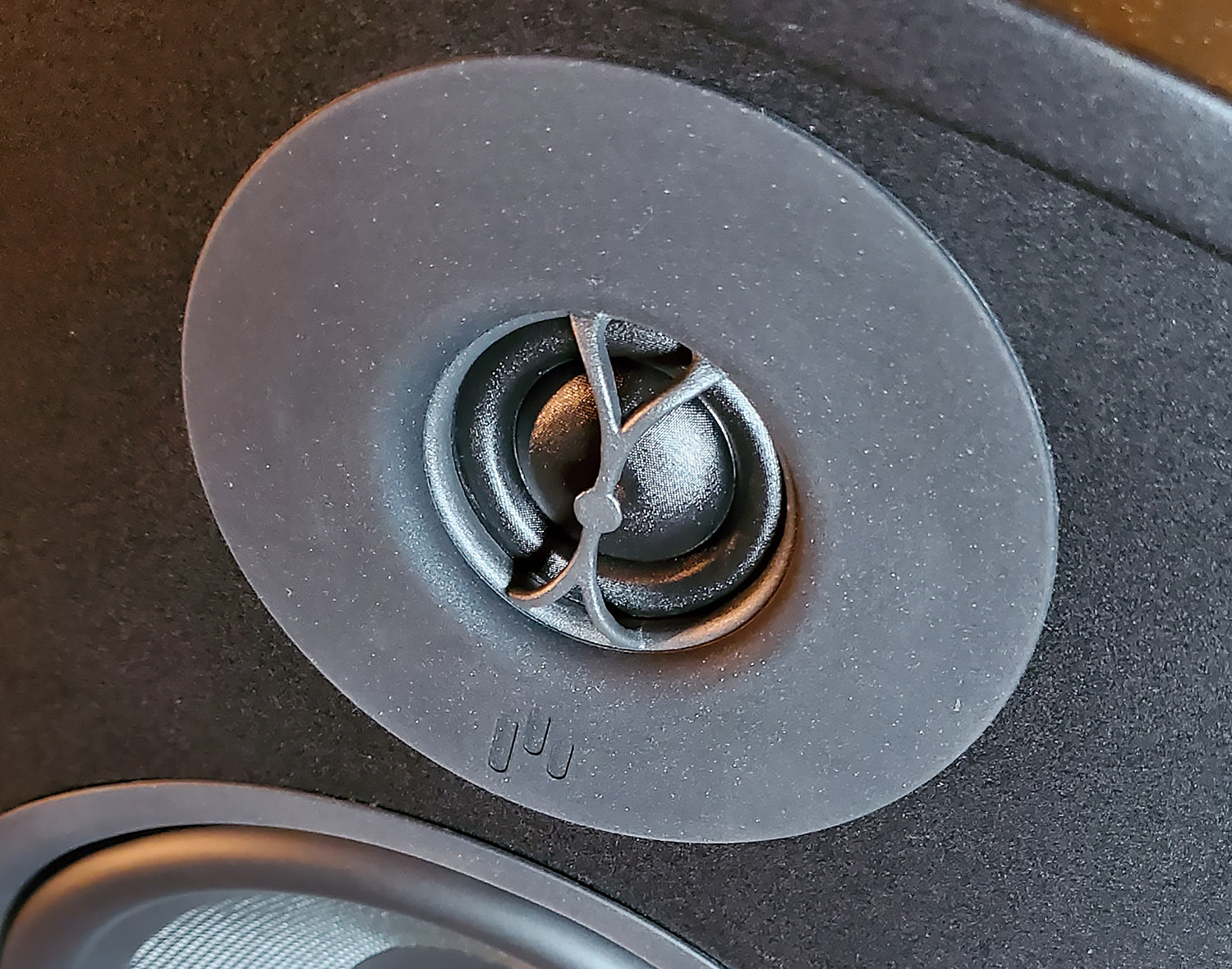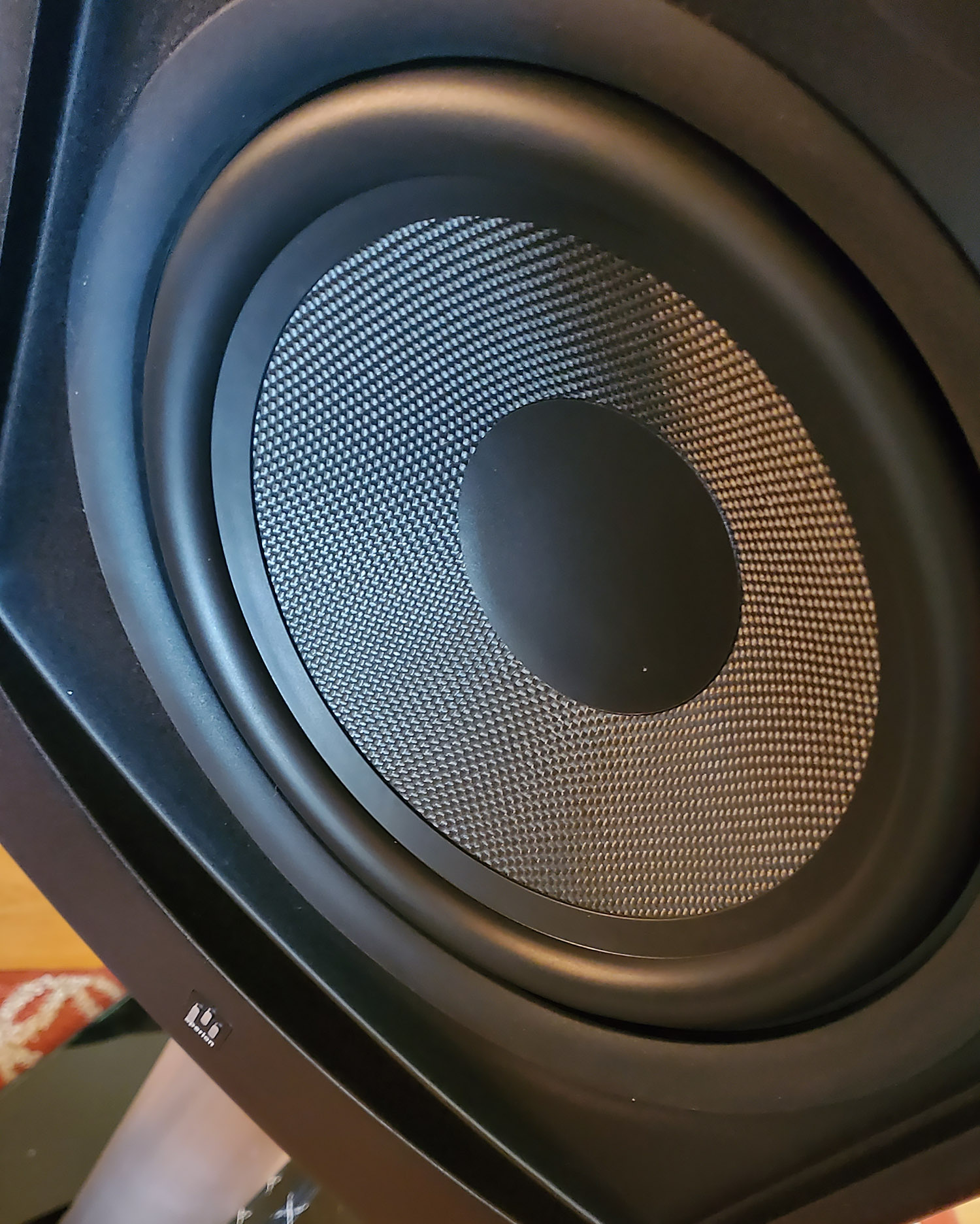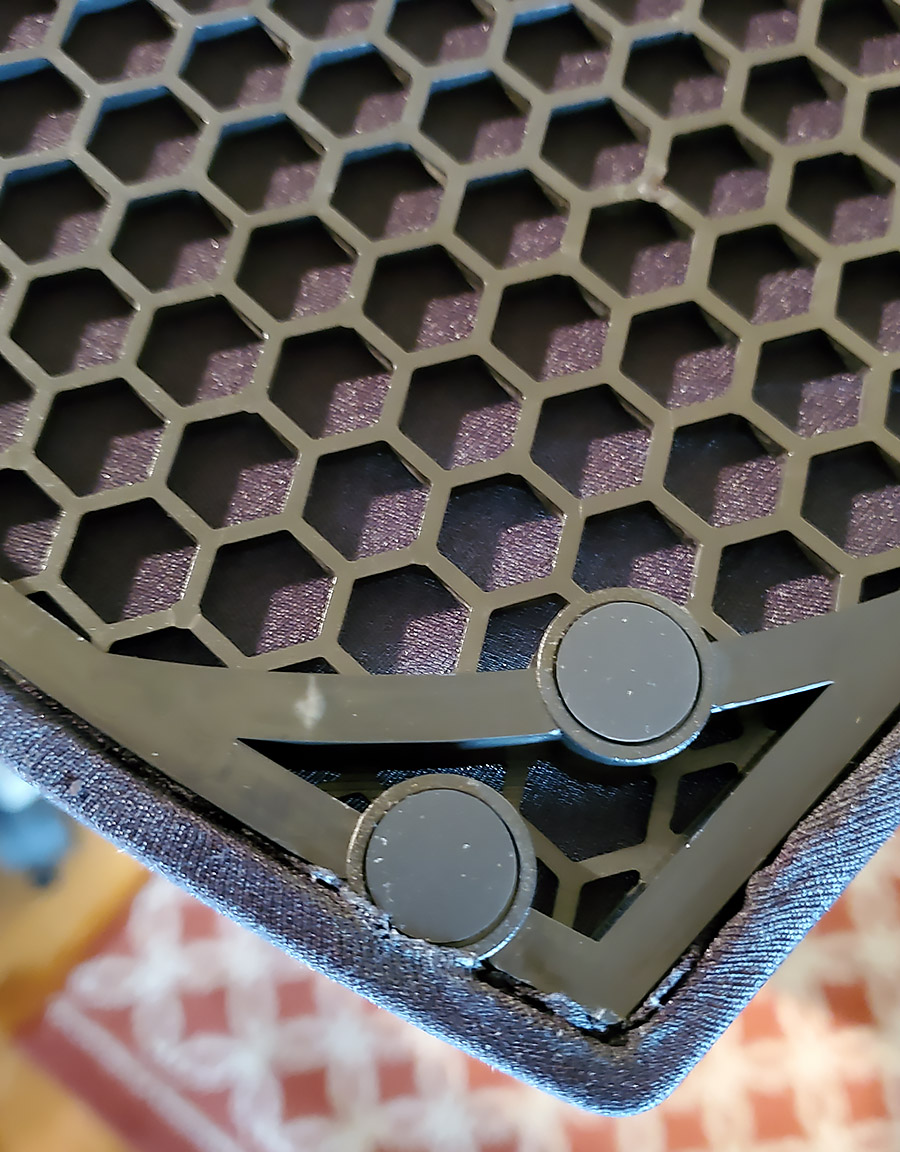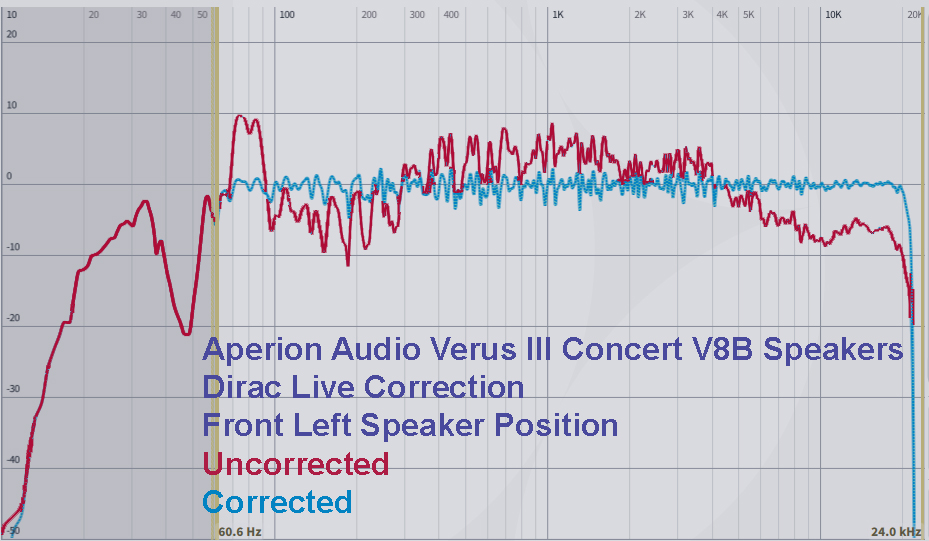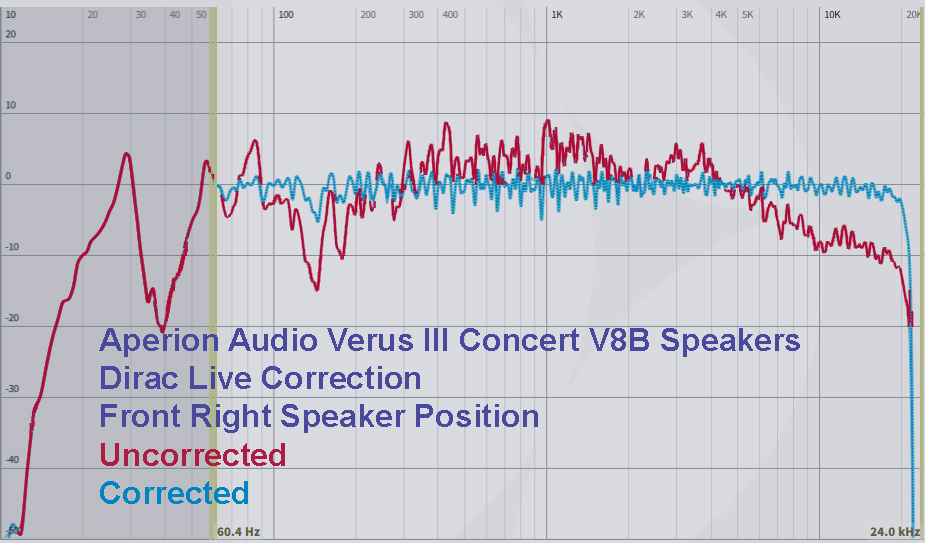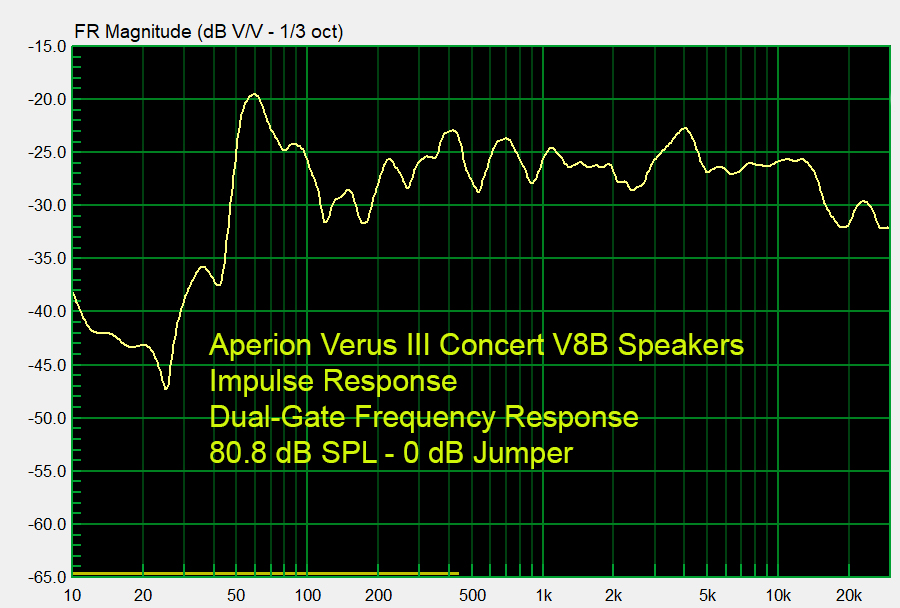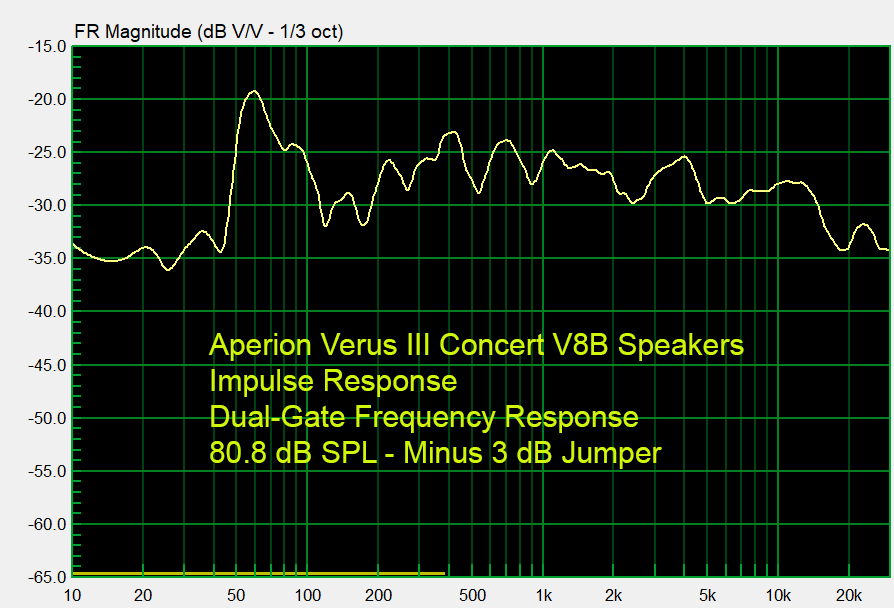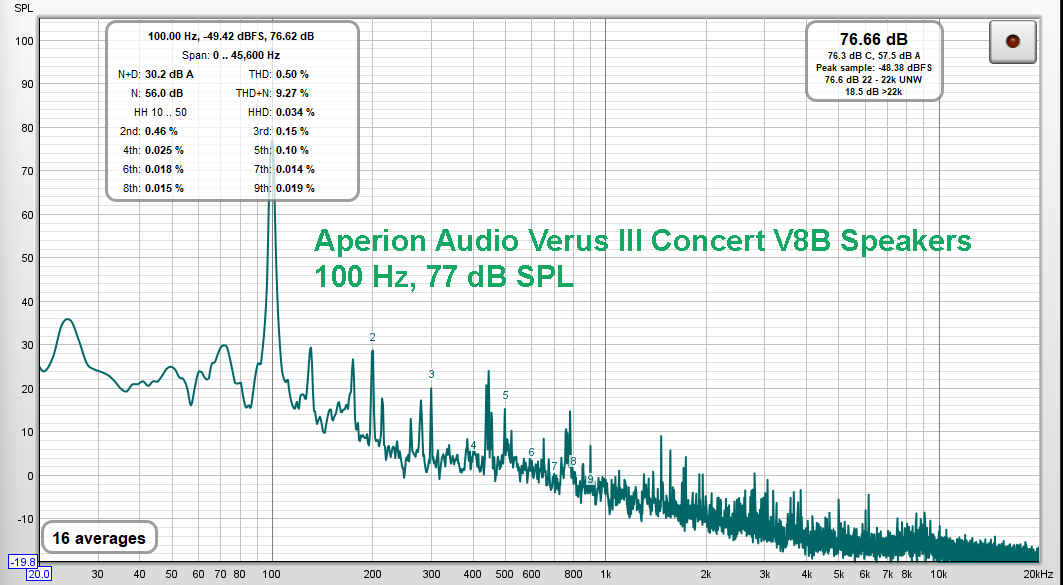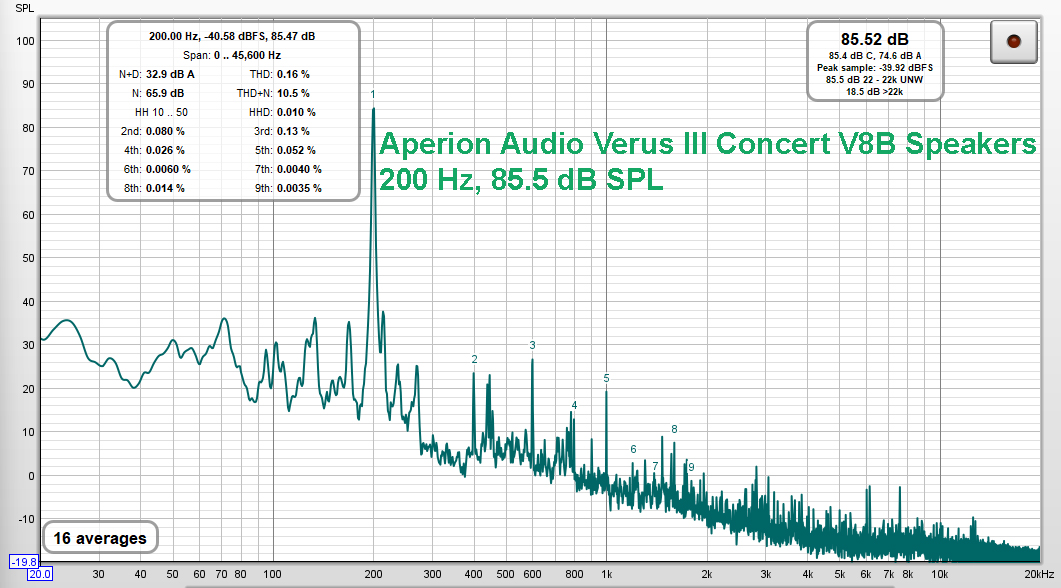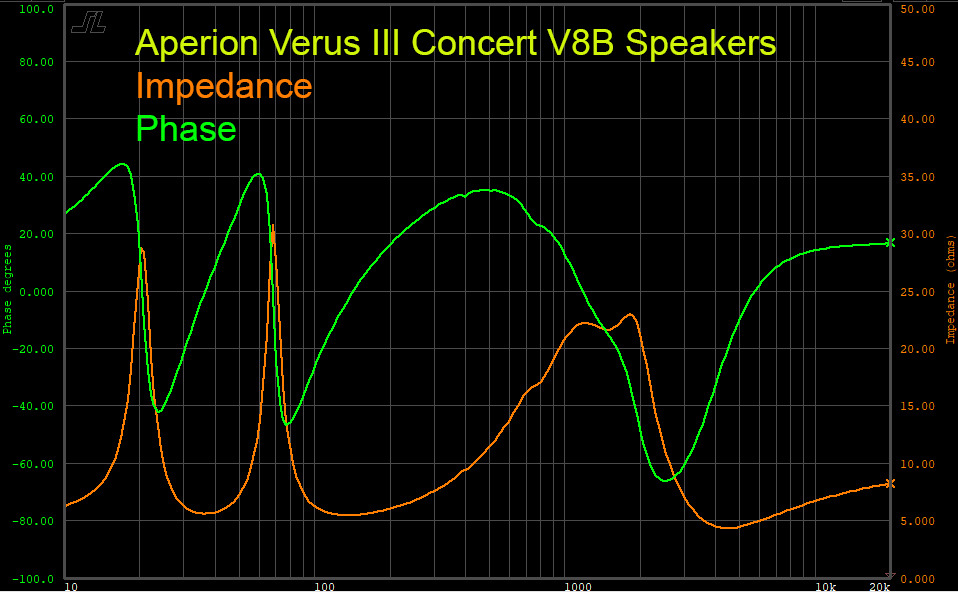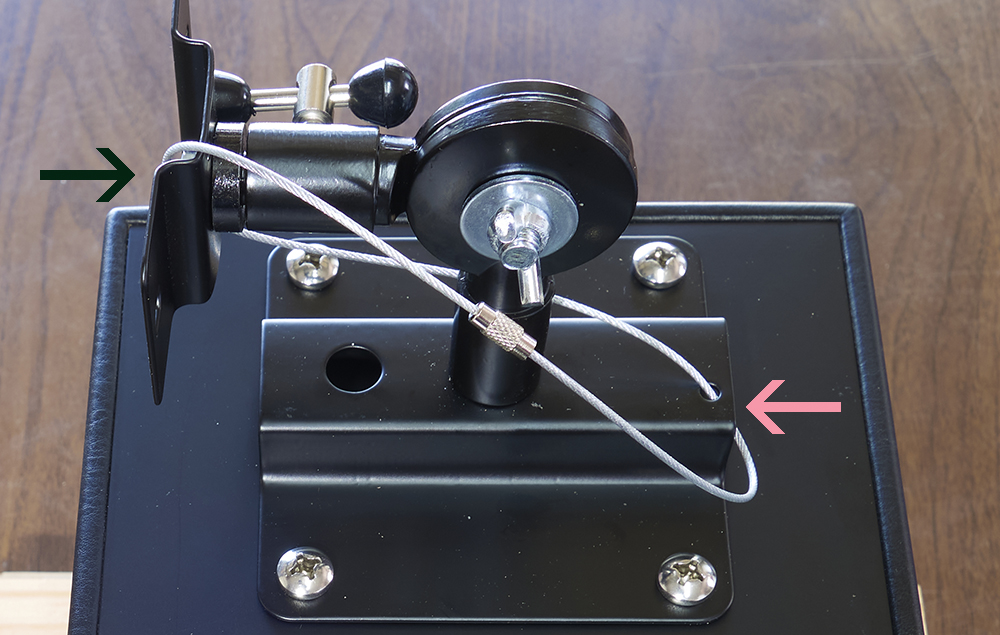Aperion Audio Versus III Concert V8B Bookshelf Speakers Highlights
- Big, bold sound
- Very nice wood finish
- Silk dome tweeter
- Bi-amp and bi-wire capability
Aperion Audio has been around for a long time, which is testimony to its success over the years. They know what their customers want.
I started a video series, “Stereo Audio & Home Theater 101+” where I described components that consumers and new aficionados to the audio and video world might find useful in setting up a home theater. In “Video 3, The Speakers” I reviewed three models of bookshelf speakers which I recommended.
Since then, I have found other models which I also feel would be good choices. One of these is Aperion Audio’s Verus III Concert V8B.
Design:
Two-way bookshelf ported on rear
Drivers:
One 28 mm (1.1”) silk-dome tweeter
One 8” woven Kevlar woofer
Crossovers:
Tweeter: 3rd-Order
Woofer: 2nd-Order
Crossover Frequency: 2.8 kHz
Binding Posts:
Bi-wire/ bi-amp
Frequency Response:
30 Hz – 35 kHz
Nominal Impedance:
6 Ohms
Sensitivity:
88 dB @ 1 Watt, 1 Meter
Finish:
Cherry or Gloss Black
Dimensions:
28” L x 18” W x 23” H
Weight:
28 pounds/each
MSRP:
$1,499/pair USD
Website:
Company:
SECRETS Tags:
speakers review, speakers reviews, speakers reviews 2023, Aperion Speakers, Aperion Speakers Reviews, Aperion Speakers Reviews 2023
The Aperion Audio Verus III Concert V8B Bookshelf Speakers are a 2-way (tweeter and woofer) bookshelf design, but they are really big, too big for any bookshelf. The category is pretty broad. I would call them a stand-mount speaker, and that is the way I set them up for listening, as the front left/right speakers in my home theater. I used a very wide angle lens to take this photograph, so the Aperion’s look somewhat larger than they actually are, and the Sony 75″ flatscreen TV looks somewhat smaller than it actually is.
The review pair was in the cherry wood veneer finish with a high gloss poly coating. They are really beautiful, and the photos don’t do them justice.


The rear panel has a port and a set of bi-amp/bi-wire binding posts. You can see that the enclosure has angled sides and rear to reduce internal standing waves.
You can disconnect the jumper wires if you want to bi-amp or bi-wire the speakers. There is also a jumper called the Treble Mod that you can change to produce a 3 dB attenuation of the high frequencies, which will soften the sound a bit.
On the front is a 28mm (1.1″) silk-dome tweeter and an 8” woven Kevlar woofer.
The grille has magnets that hold it onto the front.
All in all, a beautifully designed speaker.
I listened to the Aperion Verus III Concert V8B Speakers using an OPPO UDP-205 Universal Player, Pass Labs XP-20 Stereo Preamplifier, Pass Labs X600.8 Power Amplifiers, and Emotiva RMC-IL 9.1.6 Surround Sound Processor.

At $1,499 for the pair, I was surprised at how good these speakers sounded. The Bass was tight, the midrange clear, and the treble was smooth. I thought before using them that I might prefer the 3 dB attenuation jumper, but that turned out not to be the case.
Secrets Sponsor
I do like really deep bass, and bookshelf speakers, in general, do not have this. When the sound gets down to the 20 Hz – 40 Hz range, it just takes a much larger driver to do that, and those drivers are only available on floor-standers and subwoofers. So, the two subs that I have in my home theater deliver that deep bass, and they were active when I turned them on, as described above. I don’t think subs are necessary when listening to most music, and that worked out for me, but for movies, especially those shown in the figure above, subwoofers – powerful ones – are absolutely necessary, even with floor-standers, at least that is the case for me.
Using Dirac Live with my RMC-1L processor, the room frequency response of the Aperion Verus III Concert V8B Speakers were easy to flatten. The two figures below show the speakers’ response without EQ (red curves), and with Dirac EQ applied (blue curves). I used a 60 Hz crossover frequency from the Aperions to my subwoofers. I recommend this crossover frequency for all large bookshelf speakers and a 70 Hz crossover for smaller ones.
Note that the uncorrected frequency response in the above two graphs is the ROOM frequency response, not the frequency response taken at 1 meter in the bench test section of this review. And, they are the room response in my room, which will be different to some degree from the response in your room. All kinds of factors come into play here, such as the dimensions of the room, doorways, fireplace, chairs, etc.
Here is an impulse response-derived frequency response with the high-frequency jumper (Treble Mod) set to 0 dB. This was taken at 1 meter, on-axis. The Dual-Gate response removes some of the effects of the room, but not all of them. There are still peaks and valleys that are caused by where the signals are intersecting and partially cancel each other or partially augment one another (or fully cancel or augment).
Changing the Treble Mod jumper to the -3 dB setting produces the following frequency response. It rolls off the high frequencies but also changes the low-frequency response below 50 Hz.
I also recommend the Aperion Verus III’s as front main left/right speakers, as well as some surround positions, such as front wide and rear surround, They could be stand-mounted in all these positions. They are a bit too big, to me, for on-the-wall mounting or ceiling mounting, but it can be done as long as you don’t block the port on the rear of the enclosure.
Secrets Sponsor
Bench test measurements were taken with the microphone 1 meter from the speaker, on-axis with the center of the speaker.
First, the single-frequency distortion tests.
The woofer.
60 Hz. THD is 3.44%, but fortunately, the primary harmonic is the 2nd at 120 Hz (the harmonic orders are shown as numbers immediately above the peaks). Note: In terms of numbering harmonics, there is a 1st harmonic at the signal frequency (in this case, 60 Hz), but it is not usually mentioned because it just adds to the signal. The signal is at 69 dB, although I had set the standard 1 kHz signal at 85 dB, and I just let the other signals fall where they may. You can click on the figures to see them full size so you can read the distortion numbers in the top left corner.
100 Hz. Distortion fell to 0.5%, and the 2nd harmonic, again, is the largest.
200 Hz. Although the distortion fell further, to 0.16%, the 3rd harmonic is now the largest.
1 kHz. Again, the 3rd harmonic is larger than the 2nd harmonic, with overall distortion at 0.17%, which is good at 85 dB SPL.
And, at 10 kHz, which tests the tweeter. The 2nd-ordered harmonic is the largest. The overall THD is 0.12%, which is good because high-frequency distortion can be irritating.
19 kHz, 20 kHz. This is a test that is not often used, but I think it is important, just as it is with testing preamplifiers and power amplifiers. The results show modest distortion, with IMD at 0.14%. It is something I have just added, so we will see how it pans out with other speakers later on.
Some speaker designs wire the tweeter in reverse due to the nature of their specific crossover network. That is the case for the Aperion Audio Verus III Concert V8B as shown below in the step response. Note that the initial part of the curve goes negative followed by the positive part and then a positive second wave which represents the woofer.
I reversed the connections to the tweeter on the two pairs of binding posts at the rear of the speaker. See, now, how the initial part of the step response is positive, to match the initial part of the second waveform that represents the woofer (figure below). I did not listen to the speakers with the tweeter wiring reversed from the factory setting. It was just done here for the step response demonstration. The fact that the tweeter was purposely wired in reverse shows that Aperion has had a lot of experience in designing speakers.
Crossover networks are designed as 1st ordered, 2nd ordered, 3rd ordered, and so on. For each order, the phase is altered by 450, but the high-pass crossover and low-pass crossover phase alterations are opposite to one another. For example, with a 2nd ordered crossover, the crossover point for the high-pass and low-pass are each shifted 900, and since they are shifted in the opposite phase to one another, the high-pass and low-pass crossover points are 1800 out of phase to each other. If the tweeter and woofer are both wired in-phase, there will be a deep valley at the crossover point. By wiring the tweeter in reverse, the crossover point will be flat as it is supposed to be.
The crossover network in the Verus III is shown below. For the tweeter, the crossover is 3rd order, and for the woofer, it is 2nd order. The crossover frequency is 2.8 kHz.
Here is a diagram of a 3rd-order tweeter, 2nd-order woofer crossover network, showing the position of the inductors and capacitors, and a reversed tweeter connection.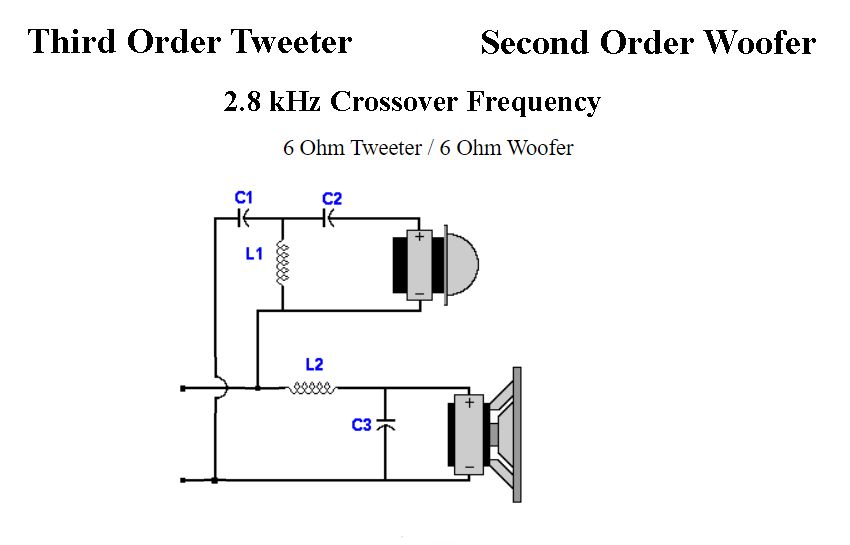
The figure below shows the Impulse Response-derived frequency response, along with harmonic distortion spread for all the frequencies. The overall response stays within a 10 dB window, except for frequencies below 60 Hz. This is why I used a 60 Hz crossover to the subwoofer in some of my listening tests. Distortion stays below 1% at 400 Hz and higher. The large dip at about 170 Hz is a suckout caused by standing waves rather than being part of the frequency response. That is life without having an anechoic chamber.
The Cumulative Spectral Display (CSD) is shown below. Enclosure resonance is pretty good, but there are several driver resonances. This is par for a large stand-mounted speaker.
Finally, here is the Impedance/Phase plot. Impedance has a low of 4 Ohms at 4.5 kHz and a high of 31.5 Ohms at 69 Hz. The phase has a low of -650 at 2.5 kHz and a high of +440 at 17.5 Hz. There is a speaker industry standard, called IEC268-5, which specifies the impedance of speakers. The lowest measured impedance must not be lower than 80% of the total impedance (nominal impedance) of the speaker. So, the lowest impedance of an 8 Ohm speaker can be 6.4 Ohms, while the lowest impedance of a 4 Ohm speaker can be 3.2 ohms. The Aperion Verus III’s are rated as 6 Ohms nominal, so the impedance cannot go below 4.8 Ohms within the IEC268-5 specification. I measured 4.5 Ohms to be the lowest impedance in the Impedance/Phase plot, which is very close to that specification. In practice, the impedance should not go below 3 Ohms for use with most power amplifiers regardless of the nominal impedance.
I have also reviewed Aperion’s Theatrus T80 Studio Monitor Speakers. They are designed for use in recording studios, and due to their low distortion and flat frequency response, I feel they make excellent speakers for use in home theaters. Read the review here.
Aperion’s Verus III Concert V8B bookshelf speakers are a winner, with great sound, engineering excellence, and beauty. They can be used as front main left/right speakers, front wide, and rear surround, on speaker stands. I feel they are too big to be hung on walls, and you don’t want to block the port on the back, but perhaps on ceilings as long as you have a catch wire loop attached so that it will be caught if the speaker mounted to the ceiling bracket comes loose. See the photo below for an example.
- Bold sound
- Careful engineering
- Good value for the dollar
- Choice of dark walnut finish
- Jumper cables a bit longer



